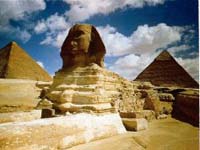Airport
Cairo International Airport
IATA Code: CAILocation: The airport is situated 14 miles (22km) from Cairo.
Time: Local time is GMT +2 (GMT +3 between last Friday in April and last Friday in September).
Contacts: Tel: +20 (0)2 265 4611.
Transfer between terminals: The two terminals are two miles (3km) apart and are linked by a free shuttle, which departs about every half an hour.
Transfer to the city: There are taxis outside the main arrivals hall; the journey to central Cairo takes around 45 minutes. An Airport Shuttle bus is a convenient way to get from the airport to downtown Cairo and along the Pyramids Road in Giza. Public buses and air-conditioned coaches also leave regularly from Terminal 1.
Taxis: There are several taxi variations from Cairo International Airport. Taxis are paid for by a flat fee at the end of the ride and nothing is discussed beforehand. The fee should be around US$5 plus a small airport exit fee. To the city centre is14 miles (22km). Cairo taxis are black and white, Alexandria taxis are black and orange.
Car rental: Car hire companies at the airport include Avis, Budget, Europcar and Hertz. However, driving in Cairo is best avoided, otherwise visitors can hire a driver with their car for a small additional charge.
Facilities: Facilities include a restaurant and several cafeterias, banks and ATMs, bureau de change, pharmacies, an Internet café in Terminal 1, five-star lounges for business and first class passengers, smoking rooms (Terminal 1), tourist information desks and travel agencies. Duty-free is also available. Facilities for disabled passengers are good, but those with special needs should contact their airline in advance.
Parking: Parking is available adjacent to Terminal 1, at a rate of EGP 5 per hour.
Departure tax: None.
Website: www.cairo-airport.com
Visit worldtravels.com for the full guide to Cairo. Build a complete Cairo travel guide and email to your clients - sign up for a trial subscription of World Travels Pro.
Cairo

Warning: Protests in Cairo have resumed as citizens call for the removal of military generals currently holding power. Visitors should avoid downtown Cairo, including Tahrir Square and the Egyptian Museum of Antiquities, as the protests have turned violent and clashes with poilce are frequent.
Africa's largest city with a population of nearly 18 million, Cairo is a chaotic mixture of sights, sounds and smells. It is heaving with life, volatile, polluted and boisterous, with an intensity that both exhausts and invigorates the visitor. It is also distinctive with its ancient monuments in juxtaposition to the modern and cosmopolitan. The congested streets of Islamic Cairo are full of donkey carts, traders and mosques, while camels weave their way haughtily between the crumbling pyramids on the outskirts. Taxis clamour for attention and pedestrians elbow their way past busy coffee houses, where those seeking a brief escape from the hustle and bustle sit sipping at a strong cup of coffee while contemplating the smoke rings of a 'hubbly bubbly' water pipe - in true Egyptian style.
Visitors can also practice the age-old art of bargaining for trinkets, spices and perfume in one of the world's largest bazaars, or pay a visit to the Egyptian Museum of Antiquities, which houses treasures from Tutankhamun's tomb and is one of the country's main attractions.
Situated on the Nile, Egyptians arrogantly refer to Cairo as the 'Mother of all Cities'; many visitors who have experienced its unruliness would perhaps describe it in less endearing terms. But no matter how it goes down there is no doubt that Cairo is as beguiling as it is messy, and its charm lies in the blend of African, Arab and European influences, the timelessness of the old, and the energy of the present.







